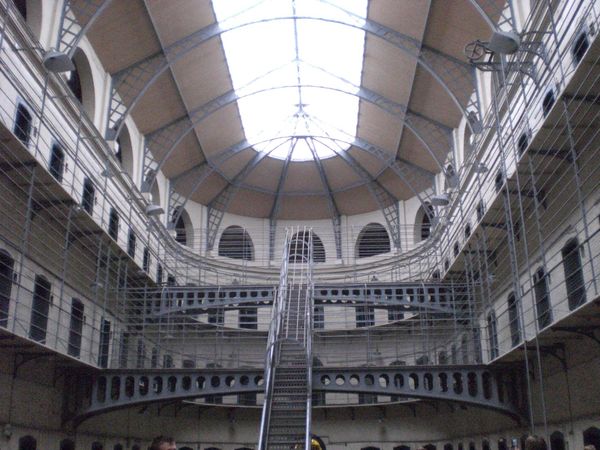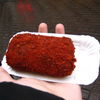The Darker Side of Dublin: Kilmainham Gaol
Lauren Plude
If your vision of Dublin is bustling pubs just oozing with Guinness and that fabled “Irish charm”, you’re absolutely right. Dublin is a wonderfully vibrant and friendly city, an oasis for any weary traveler looking for a warm smile and a cold pint. However, Dublin’s revolutionary history runs much deeper and significantly darker than the thriving pub culture suggests. So while I highly recommend kicking up your heels to some traditional Irish music at your nearest pub, no Dublin experience is complete without paying your respects to Ireland’s turbulent political history at Kilmainham Gaol.
Now you may be wondering why I’ve just recommended that you spend part of your lovely holiday in a prison. (Yes, a prison. Gaol is the Irish equivalent of the English “jail”.) Simply, this prison turned museum is perhaps the most moving tribute to modern Irish history you’ll find. So now, with Kilmainham as your guide, get ready to dive into one of the most epic, revolutionary, and romantic tales in the Irish fight for independence.
I’m talking about the Easter Rising of 1916. The abbreviated version of this story is this: On April 24, 1916 a group of Irish rebels lead by Padraig Pearse took control of the Dublin General Post Office and declared Ireland’s independence from Britain. Upon their surrender, the leaders of this failed rebellion were imprisoned and executed in Kilmainham. However, the spark ignited by the outrage over the execution of these revolutionaries fueled the flames that would eventually lead to the Republic of Ireland, as we know it today. Whew, that was a quick run through of a very complex historical event. I promise, you’ll get a much more detailed telling of this story on your visit to Kilmainham.
At Kilmainham you’ll hear the personal stories of the men who lead this rebellion including being able to read their final letters to their loved ones, see their cells, and even be taken out to the courtyard where they were executed. Beyond the story of 1916, Kilmainham has held several other famous Irish citizens including: Robert Emmet, Jeremiah O’Donovan Rossa, and Charles Stewart Parnell, whose stories you’ll hear. Also, from a social reform perspective, the guides give you a real sense of what life was like for those incarcerated at Kilmainham, explaining everything right down to the logic behind the layout of the prison. And for any film buffs, a tour of Kilmainham gives you the chance to see for yourself a location found in films such as: Michael Collins (Trivia: Even though parts of this movie were filmed at Kilmainham, Collins himself was never actually imprisoned there.), and In the Name of the Father.
The experience of Kilmainham Gaol is more overwhelming and emotional than you can imagine and not for the faint of heart as parts of this tour can be a little disturbing (Hence, I wouldn’t recommend taking young children on this tour). But, this intensely emotional encounter (Okay, I’ll admit it, I cried on the tour more than once. I’m a girl, what did you expect?) will only enrich your appreciation for the history that shaped this amazing city.
TIP: If you’d like to read more about the Easter Rising before your trip to Kilmainham Gaol, I highly recommend Morgan Llywelyn’s novel, 1916. A novel instead of a textbook, 1916 walks you through the events of the Easter Rising with a blend of both fact and fiction. It makes for excellent in-flight reading.
Featured Articles
If you are looking to sum up Barcelona in one word, in a city as large and eclectic as this Spanish gem, it is possible: colorful.
From multi-tier cakes to underground record shops, truly neighborhood restaurants (where English might not be on the menu) and where to rent a bike that won't make you look like a tourist - this guide brings you seven fairly hidden - and absolutely delightful spots in Amsterdam for those looking for something different.
Ireland’s capital offers plenty to see in its own right, but the chance to get away and take a look at some of the trademark greenery of the emerald isle shouldn’t be missed.
High on the list of day trips is Karlovy Vary, a town located near the German border in what is considered the Bohemia area of the Czech Republic
When you think of the Netherlands, “culinary expertise” is not a phrase that comes to mind.
Free Backpacking Europe Planning & Essentials Guide
Download/More info on the Backpacking Planning and Essentials Guide
Featured Articles
If you are looking to sum up Barcelona in one word, in a city as large and eclectic as this Spanish gem, it is possible: colorful.
From multi-tier cakes to underground record shops, truly neighborhood restaurants (where English might not be on the menu) and where to rent a bike that won't make you look like a tourist - this guide brings you seven fairly hidden - and absolutely delightful spots in Amsterdam for those looking for something different.
Ireland’s capital offers plenty to see in its own right, but the chance to get away and take a look at some of the trademark greenery of the emerald isle shouldn’t be missed.
High on the list of day trips is Karlovy Vary, a town located near the German border in what is considered the Bohemia area of the Czech Republic
When you think of the Netherlands, “culinary expertise” is not a phrase that comes to mind.
Free Backpacking Europe Planning & Essentials Guide
Download/More info on the Backpacking Planning and Essentials Guide




